Crucial Advice to Prevent Frozen Plumbing in Winter: Professional Guidance
Crucial Advice to Prevent Frozen Plumbing in Winter: Professional Guidance
Blog Article
They are making a number of good pointers related to Winter Plumbing Precautions: Preventing Frozen Pipes as a whole in the content underneath.

Cold weather can ruin your pipes, particularly by freezing pipes. Right here's exactly how to prevent it from happening and what to do if it does.
Intro
As temperature levels decline, the risk of frozen pipelines rises, potentially resulting in costly repairs and water damage. Comprehending how to stop icy pipes is essential for property owners in cold environments.
Prevention Tips
Protecting vulnerable pipes
Cover pipelines in insulation sleeves or use warm tape to shield them from freezing temperature levels. Concentrate on pipelines in unheated or outside areas of the home.
Heating methods
Keep interior spaces sufficiently heated up, especially areas with plumbing. Open cabinet doors to allow cozy air to flow around pipelines under sinks.
How to recognize icy pipelines
Search for lowered water flow from taps, uncommon odors or noises from pipes, and visible frost on exposed pipes.
Long-Term Solutions
Architectural modifications
Consider rerouting pipes far from outside wall surfaces or unheated locations. Include added insulation to attic rooms, basements, and crawl spaces.
Upgrading insulation
Purchase high-quality insulation for pipes, attics, and wall surfaces. Correct insulation assists keep regular temperatures and minimizes the threat of frozen pipes.
Securing Outdoor Pipes
Yard pipes and outdoor taps
Disconnect and drain pipes garden pipes prior to wintertime. Set up frost-proof spigots or cover outdoor faucets with shielded caps.
Understanding Icy Pipelines
What triggers pipes to freeze?
Pipelines ice up when exposed to temperatures listed below 32 ° F (0 ° C) for extended periods. As water inside the pipelines ices up, it expands, taxing the pipeline wall surfaces and potentially triggering them to break.
Risks and problems
Frozen pipes can lead to water supply interruptions, building damages, and costly repair services. Burst pipes can flood homes and create considerable structural damages.
Indicators of Frozen Piping
Recognizing frozen pipes early can stop them from rupturing.
What to Do If Your Pipes Freeze
Immediate activities to take
If you presume frozen pipelines, maintain faucets open to alleviate pressure as the ice thaws. Utilize a hairdryer or towels soaked in hot water to thaw pipelines slowly.
Final thought
Stopping frozen pipelines calls for proactive actions and quick reactions. By recognizing the causes, indications, and preventive measures, property owners can safeguard their pipes throughout cold weather.
5 Ways to Prevent Frozen Pipes
Drain Outdoor Faucets and Disconnect Hoses
First, close the shut-off valve that controls the flow of water in the pipe to your outdoor faucet. Then, head outside to disconnect and drain your hose and open the outdoor faucet to allow the water to completely drain out of the line. Turn off the faucet when done. Finally, head back to the shut-off valve and drain the remaining water inside the pipe into a bucket or container. Additionally, if you have a home irrigation system, you should consider hiring an expert to clear the system of water each year.
Insulate Pipes
One of the best and most cost-effective methods for preventing frozen water pipes is to wrap your pipes with insulation. This is especially important for areas in your home that aren’t exposed to heat, such as an attic. We suggest using foam sleeves, which can typically be found at your local hardware store.
Keep Heat Running at 65
Your pipes are located inside your walls, and the temperature there is much colder than the rest of the house. To prevent your pipes from freezing, The Insurance Information Institute suggests that you keep your home heated to at least 65 degrees, even when traveling. You may want to invest in smart devices that can keep an eye on the temperature in your home while you’re away.
Leave Water Dripping
Moving water — even a small trickle — can prevent ice from forming inside your pipes. When freezing temps are imminent, start a drip of water from all faucets that serve exposed pipes. Leaving a few faucets running will also help relieve pressure inside the pipes and help prevent a rupture if the water inside freezes.
Open Cupboard Doors
Warm your kitchen and bathroom pipes by opening cupboards and vanities. You should also leave your interior doors ajar to help warm air circulate evenly throughout your home.

Hopefully you liked our excerpt on How To Avoid Freezing Pipes. Thanks for spending some time to read our content. I beg you take a moment to share this blog entry if you enjoyed reading it. We truly appreciate your readership.
Schedule Estimate Report this page